

From Coding to Coding: As we saw from the many sessions about coding during ISTE 2015, the topic of programming computers is back in fashion.
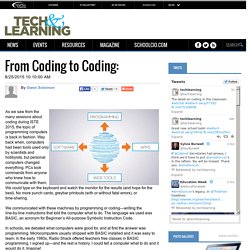
Way back when, computers had been tools used only by scientists and hobbyists, but personal computers changed everything. PCs took commands from anyone who knew how to communicate with them. We could type on the keyboard and watch the monitor for the results (and hope for the best). No more punch cards, greybar printouts (with or without fatal errors), or time-sharing. We communicated with these machines by programming or coding—writing the line-by-line instructions that told the computer what to do.
In schools, we debated what computers were good for, and at first the answer was programming. I wrote a grant proposal for a classroom full of TRS-80s. The very first issue of Classroom Computer News (CCN) in 1980 celebrated programming. He designed Gramaze, a game to help students identify direct objects in sentences. Makerspace Resources and Programming ideas. (Updated post from my Podbean Site) Summer 2014 I was asked to present a webinar to Ohio School Librarians for InfOhio.
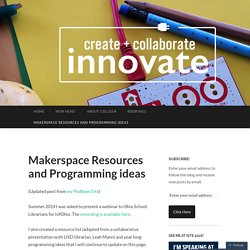
The recording is available here. I also created a resource list (adapted from a collaborative presentation with LISD librarian, Leah Mann) and year long programming ideas that I will continue to update on this page. WEBINAR RECORDING: Makerspace-Playbook-Feb-2013.pdf. A Librarian's Guide to Makerspaces: 16 Resources. "There were more than 135 million adult makers, more than half of the total adult population in America, in 2015.
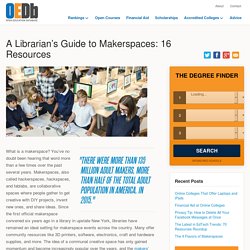
" What is a makerspace? You’ve no doubt been hearing that word more than a few times over the past several years. Makerspaces, also called hackerspaces, hackspaces, and fablabs, are collaborative spaces where people gather to get creative with DIY projects, invent new ones, and share ideas. Since the first official makerspace convened six years ago in a library in upstate New York, libraries have remained an ideal setting for makerspace events across the country. Many offer community resources like 3D printers, software, electronics, craft and hardware supplies, and more. There were more than 135 million adult makers, more than half of the total adult population in America, in 2015.
Articles & Blog Posts on Makerspaces 1.) 2.) 3.) 4.) 5 Engineering Challenges with Clothespins, Binder Clips, and Craft Sticks. Five engineering challenges for kids – with wooden clothespins, binder clips, and craft sticks!
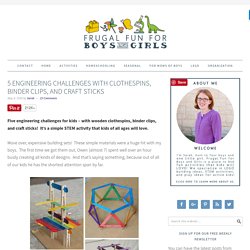
It’s a simple STEM activity that kids of all ages will love. Move over, expensive building sets! These simple materials were a huge hit with my boys. The first time we got them out, Owen (almost 7) spent well over an hour busily creating all kinds of designs. And that’s saying something, because out of all of our kids he has the shortest attention span by far. Engineering Project for Kids: Build a Straw Roller Coaster! Genius Hour 2017 Jones - Google Slides. Genius Hour Planning Form 2017 (1).docx. Geniushour - home. Genius Hour / 20% Time. 9 Maker Projects for Beginner Maker Ed Teachers - Blog. 7 tips for creating a learner-centered makerspace. How Fair Is Your Maker Space? All students should be able to benefit from maker spaces and maker education, which emphasize student-driven learning and foster the development of 21st-century skills.

However, not all maker spaces and activities are created equal. Some feature high-tech equipment such as 3-D printers and scanners, programmable robots, mini-computers, and high-tech construction toys—equipment carrying a hefty price tag that not all schools can afford. In addition, maker space activities may cater to certain kids’ interests but not others—including dynamics that educators might not even be aware of. Starting a School Makerspace from Scratch. With the National Week of Making behind us, you might be ready to start a makerspace in your school -- but not know where to start. Will purchasing a costly 3D printer and the latest robotics kit ensure learning and maker success? What are some steps to starting a successful makerspace from scratch? Step 1: Immerse Yourself in Maker Education Before you can build your own community of makers, you need to join one!
Immerse yourself in makerspaces by joining a summer maker camp like Exploratorium's Tinkering Fundamentals or the virtual Camp Google for cheap and easy STEM ideas, but most importantly: make stuff! Step 2: Get Others Involved. Create a school makerspace in 3 simple steps. As maker education gains steam, many educators are looking for ways to incorporate making and tinkering into their schools and classrooms — often on a shoestring budget. “Kids are saying they want to learn more about technology and science, but they also want to experience it creatively and use it personally,” said Dale Dougherty, founder of Make Media, which produces Maker Faire and Make Magazine.
He’ll address how educators can deliver these types of experimental learning experiences during ISTE 2014’s EdTekTalks, a provocative series of mini-keynotes from thought leaders beyond the world of ed tech. “One of the ways we can do that is create more makerspaces for kids. Part of my talk will be leading the charge to say let’s build more makerspaces inside schools, libraries and even community centers.” Makerspace Starter Kit.
The hot new Makerspace Movement is NOT new to Murray Hill Middle School.
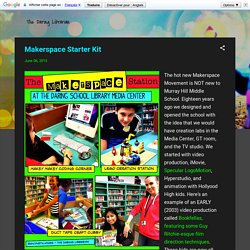
Eighteen years ago we designed and opened the school with the idea that we would have creation labs in the Media Center, GT room, and the TV studio. We started with video production, iMovie, Specular LogoMotion, Hyperstudio, and animation with Hollyood High kids. Here's an example of an EARLY (2003) video production called Bookfellas, featuring some Guy Ritchie-esque film direction techniques.
Want to Start a Makerspace at School? Tips to Get Started. As the Maker Movement starts to gain momentum, schools that are trying to find ways to foster the do-it-yourself environment can learn a few lessons from another nexus in the universe: public libraries.
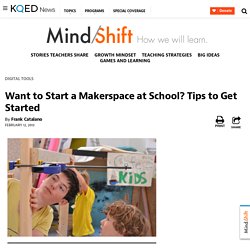
Dale Dougherty, founding editor and publisher of Make Magazine — and the de facto leader of the Maker Movement — has a vision to create a network of libraries, museums, and schools with what he calls “makerspaces” that draw on common resources and experts in each community. Libraries and museums, he said, are easier places to incorporate makerspaces than schools, because they have more space flexibility and they’re trying to attract teens with their programs. “Schools have already got the kids,” Dougherty noted wryly, at the recent American Library Association Midwinter Meeting in Seattle.
One day during the conference, dubbed Maker Monday, focused on the Maker Movement, which emphasizes learning by engaging in tech-related projects. “Why are you here?” FAQs about Makerspaces. What is needed to start a Makerspace in a classroom or school?

Passion - You need to have passion and a belief in the educational value of maker-style projects. Space - This can be a whole room or only part of a room. Supplies - Start small with simple craft materials. Often sending a message out to colleagues and the community asking for donations of materials works well. Storage - Create a place to store materials when they are not in use and student projects as they are being worked on.
Where should the Makerspace be placed? Makerspaces can be located just about anywhere, but there are certain spaces that make more sense in a school setting. 27 Makerspace Materials & Supplies - Makerspaces.com. Free Supply List (PDF) – 100+ Makerspace Materials and Supplies What makerspace materials and supplies should you buy or stock for your hands-on learning lab?

There are a lot of options out there to choose from and it can be confusing when you’re first starting out as a maker educator. Instead of just spending money randomly on items you think you will need, it’s always a great idea to work backwards first. You need to make a list of your goals for your makerspace and then define some of the projects you want to do in your makerspace. Once you have defined the projects, you will have a better idea of the materials you need to buy. Goodpbl. The Flipped Learning Process Visually Explained. April 2, 2015 After yesterday’s post on “Flipped Learning Resources” one of our readers emailed us this beautiful visual outlining the six main steps involved in the creation of a flipped classroom.
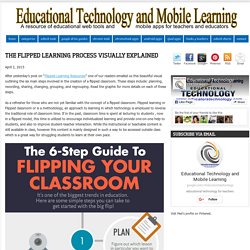
Project-Based Learning. Manufacturing Makerspaces. Kids gather to make Lego robots; teens create digital music, movies, and games with computers and mixers; and students engineer new projects while adults create prototypes for small business products with laser cutters and 3D printers. Many libraries across the US have developed makerspaces—places to create, build, and craft—and they are experiencing increased visits and demand as a result.
For public libraries, they are places to promote community engagement. Why the 'Maker Movement' is Popular in Schools. The maker movement is a global, DIY movement of people who take charge of their lives, solve their own problems and share how they solved them. And it's growing in schools that are searching for more authentic learning experiences for their students. Since the beginning of time, people have made things to solve problems and otherwise improve their quality of life.
But previously, the amount of exposure individual projects received was limited. Now the Internet has driven projects into the limelight. "These things that used to be isolated are now shared widely," said Sylvia Libow Martinez, president of nonprofit education technology organization Generation YES and co-author of the book Invent to Learn. She shared an example of how this global movement works. From kindergarten to second grade, students traditionally make things with playdough, legos and other objects.
And parents have been telling Libow Martinez that something needs to change. Creating a School Library Makerspace: The Beginning of a Journey. Our library at Silver Creek High School in Longmont, CO is an active hub for extracurricular activities. Makerspaces - Beyond the Buzzword. 25 Makerspace (STEM / STEAM) Projects For Kids. Makerspace or STEM projects for kids don’t have to be complicated or expensive. In fact, some of the best projects use recycled or repurposed items like cardboard or soda bottles which means nothing to buy. Below, we’ve compiled some of our favorite projects that are great for makerspaces.